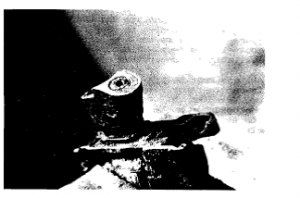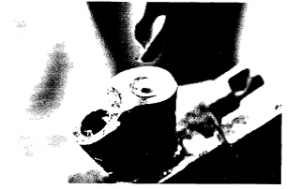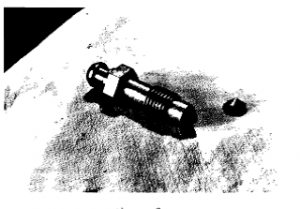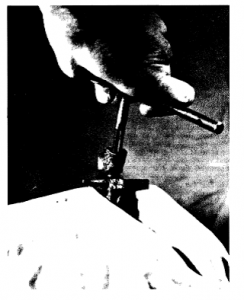by Gary Durborow and Tom Ehrhart in the April 1982 RootesReview:
Many Sunbeam owners have discarded wheel cylinders and clutch slave cylinders needlessly because the bleeder screws broke off while trying to remove them. For the most part, these cylinders can be repaired quite easily at a considerable savings over the price of a new one.
The fix is rather simple and all one needs is:
- 3/8th-inch by 24-thread tap (bottoming type if possible)
- 11/32nd-inch drill bit
- drill press (preferred) or hand drill
- vise
- luck
The first picture illustrates a typical grimy wheel cylinder with the bleeder screw broken off. Note how the break is clean and there is a small hole right down the center.
To start, mount the cylinder in a vise and, using the 11/32nd-inch bit, drill out the old bleeder screw (see second picture). When doing this make sure you drill straight down the center of the bleeder screw. That is why the drill press is preferred. The nice part about the hole down through the center is that it acts like a pilot hole and helps keep the bit centered while drilling.
 You only need to drill down to just past the end of the threads, so remove the drill often and look down the hole to note your progress. It is very easy to see.
You only need to drill down to just past the end of the threads, so remove the drill often and look down the hole to note your progress. It is very easy to see.
By drilling down to the end of the threads and, just a bit more, a small section of the bleeder screw will remain inside. To remove this part, it may be necessary to invert the cylinder and gently tap it or pick the piece out with an ice pick, nail, etc. The piece removed from the wheel cylinder in this project is shown beside a good bleeder screw.
New bleeder screws are readily available at most auto parts houses, or you could snatch one out of that pitted cylinder you’re throwing away. (If you had used silicone fluid, it wouldn’t be pitted.)
After the bleeder screw is removed, re-tap (chase) the threads. Try to start the tap in the original threads, although it really isn’t necessary.
 This entire process can be carried out while the cylinder is still on the car–if you’re good. If you should choose to do it this way, be sure to top up the reservoir with fluid before starting. In this way, the metal fillings will be washed out while you re-tap the threads. It’s a messy job, but owning a limey car has already conditioned you for that, eh wot?
This entire process can be carried out while the cylinder is still on the car–if you’re good. If you should choose to do it this way, be sure to top up the reservoir with fluid before starting. In this way, the metal fillings will be washed out while you re-tap the threads. It’s a messy job, but owning a limey car has already conditioned you for that, eh wot?
Just think, the money you save from this little operation will enable you to renew your membership in Tigers East/Alpines East for at least two more years! Let’s not hesitate, send that money now!
